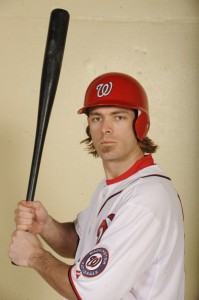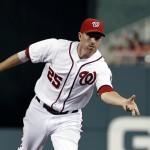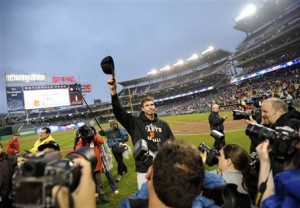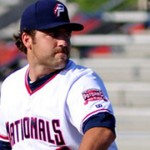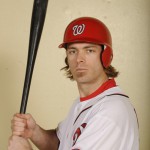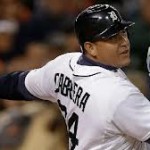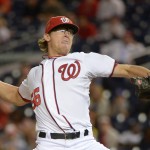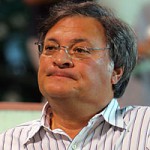
The team gets the lead-off hitter it has needed for years in Denard Span. Photo Bruce Kluckhohn/Minnesota Twins via twitter
At least Nats fans can start understanding the team’s off-season plans a little more clearly now. The first domino has fallen. The Nats acquired Denard Span from Minnesota for Alex Meyer yesterday.
I’ve argued against a center field acquisition for a while now. Here’s three primary reasons why:
1. I don’t feel the Nats needed a center fielder. Bryce Harper put up a 17.6 UZR/150 in 715+ innings while showing a plus-plus arm (both statistically and for any casual observers). He’s just turning 20. There is no reason to think he cannot ably patrol center for at least the next few years. I’ve used this analogy before, but I feel like its the Yankees approaching Mickey Mantle after his first season in center and saying, “Hey Mick, we like you in center but we have this barely above league average guy At least until point #2 possibly comes to play:
2. Brian Goodwin, along with Destin Hood, Eury Perez, Michael Taylor and any other marginal OF prospect the team has is now effectively blocked for at least the next 3 years and possibly longer. Span is signed through 2014 (with a very affordable 2015 option), Jayson Werth signed through 2017, and Harper is under team control through at least 2017. There’s your outfield for the next 3 years guaranteed, 2/3rds of which is locked up for the next 5. I just feel that the better path would have been to let Harper play CF until Goodwin or Perez seems ready (clearly Godwin is an upper-end prospect who has impressed ever since he was drafted, and the team didn’t add Perez to their 40-man roster just to give him the extra salary) and just make do with a slugger in left field.
3. The loss of Alex Meyer represents the best healthy starter arm in the entire system, a system which is becoming thinner and thinner (with this trade on the backs of the Gio trade I’d guess the Nats are now going to be in the bottom 5 farm systems when rankings start coming out). You can argue whether or not Meyer was going to stick as a starter (see the “bright side” points below), but inarguably this weakens the farm system in general and further weakens a specific problem that may pop up sooner than later; starting pitcher depth. If one of our big 4 suffers a spring training injury, it is difficult to see who may step up and be counted on for starts.
This move clearly forces the Nationals hand on Michael Morse, and now the team may end up negotiating from a point of weakness if they need to move him. The decision path for the team now is clearly “Morse or LaRoche” at first base. If the team does bring back Adam LaRoche suddenly Morse is without a lineup spot and his trade value diminishes quickly. If the rumors are true that LaRoche is “only” seeking a 3 year deal, the Nats should stumble over themselves to offer him a 3 year deal (3yrs $40M seems more than fair based on what LaRoche did for us last year) and lock up the plus-defender/middle of the order bat.
This move also cannot be a happy day for Tyler Moore; he’s clearly set on being a backup now in 2013 no matter what happens with Morse/LaRoche, despite promising numbers in 2012. Well, unless the team fails to re-sign LaRoche AND moves Morse (which I suppose is still possible but would make little sense), which would then install Moore as the every day first baseman. Between Moore, Morse possibly being out of a position and Goodwin being blocked for years to come, you have to think we’re going to see some more moves involving these players (hopefully to acquire a starter, or some starter depth in the minors).
Now, on the bright side (since I’ve been accused of being too negative in my analysis), I will say the following:
1. We did not give up a ton for Span. I like Meyer, but I’m afraid he may not stick as a starter. The scouting knock on him has always related to his tall frame and repeatability of his delivery. He has a funky leg kick and slightly weird mechanics, further muddying the waters. Lastly he’s a huge guy and he (at first glance in videos) seems to really throw standing up and doesn’t use a ton of his lower body. All of this spells “reliever” in his future. If Meyer tops out as a fireballing reliever, this trade looks even better.
2. Span inarguably fills a need; a high OBP leadoff hitter. He’s a .357 career OBP guy with speed and who hits lefty, a nearly perfect fit for what this lineup needs at the top. Leadoff hitters generally come from one of three positions: CF, SS and 2B. If the team decided it NEEDED a leadoff guy, and with Desmond and Espinosa locked into the SS and 2B slots for the time being, clearly the only place the team could go was a center-fielder. The USAToday article linked at the top said it best (paraphrasing): this move is as if you bought a new chair for your living room, which forced you to have to move around your furniture. You didn’t necessarily need the new chair, but it certainly makes your living room look better. This move enables Werth to move further down in the lineup and return to his power stroke.
3. We didn’t spend good money after bad on BJ Upton or Michael Bourn, who’s 5yr/$75M demands would have been a real waste of money. Span’s contract is great: 5yrs for $16.5M guaranteed plus a $9M option in 2015. The Nats acquired a desired resource without appreciably increasing payroll, allowing them to focus (perhaps) on a FA starter.
Initial reaction to the trade in the Baseball World seems mixed, which is great since it probably indicates that this is a pretty fair trade all in all. Keith Law doesn’t like it of course, but that’s because Law believes every low-minors big arm is turning into Justin Verlander (Law also thought the Gio Gonzalez trade was a “huge win” for Oakland because they got AJ Cole, the same AJ Cole who put up a 7.82 ERA in high-A this year and was forced to repeat Low-A). Meanwhile Dave Cameron calls this a “huge win” for Washington, focusing on Span’s numbers and mentioning the same concerns about Meyer that I do. Rob Neyer pays a complement to Mike Rizzo and the Nats and says the team is well-positioned for several years. Ken Rosenthal talks about the about-face the franchise has done in the last 3 years in the eyes of potential Free Agents, specifically Zack Greinke, who declined the Nats trade offer 2 years ago but now could be the final piece in building a juggernaut.
Coincidentally, those who think this moves Harper to LEFT field may be mistaken. Werth’s defense in right has inarguably slipped (he posted a -14.2 UZR/150 in right this year, a significant drop from his previous decent-to-good seasons there). I think Harper should play right field, with his gun for an arm protecting against 1st-to-3rd runners while Werth should immediately put up great UZR numbers in left. Possible lineup in 2013 (assuming for now that LaRoche is leaving):
- Span (L) – CF
- Werth (R) -LF
- Zimmerman (R) – 3B
- Harper (L) – RF
- Morse (R) – 1B
- Desmond (R) – SS
- Espinosa (S) – 2B
- Suzuki (R) – C
- Pitcher.
L-R-R-L-R-R-S-R for good balance. I could also see Desmond and Werth switching spots in the lineup. Harper to cleanup may be a bit early, but without adding another lefty bat the lineup could have too many right-handed hitters in a row.
Now, what if LaRoche re-signs? Then suddenly this lineup has pretty good balance. With LaRoche in the fold i’d probably go like this:
- Span (L) – CF
- Werth (R) -LF
- Harper (L) – RF
- Zimmerman (R) – 3B
- LaRoche (L) – 1B
- Desmond (R) – SS
- Espinosa (S) – 2B
- Suzuki (R) – C
- Pitcher.
That’d be a slight modification over where these guys hit last year, but would give nearly perfect lefty-righty balance.
In the end, you have to give up something you value to get something you value. The Nats made a good trade, despite my thinking they didn’t need to make the trade in the first place. They’re an improved team on the field for 2013.
